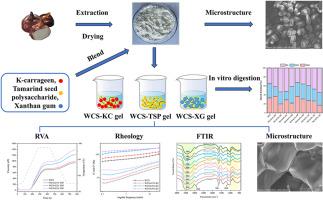与不同水胶体共糊化的荸荠(Eleocharis dulcis Burm.f.,香柏科)淀粉的糊化、结构特性和体外消化率
IF 11
1区 农林科学
Q1 CHEMISTRY, APPLIED
引用次数: 0
摘要
本研究旨在探讨卡拉胶(KC)、罗望子多糖(TSP)和黄原胶(XG)对荸荠淀粉(WCS)糊化、流变、结构特性和体外消化率的影响。糊化结果表明,黄原胶提高了马蹄淀粉凝胶的峰值粘度(PV)、谷值粘度(TV)、终粘度(FV)和分解粘度(BD),但降低了后退粘度(SB),TSP则显著提高了后退粘度(SB)。流变学数据发现,KC、TSP 和 XG 增加了 WCS 的表观粘度、储存模量(G′)和损耗模量(G″),并随着亲水胶体浓度梯度的增加而逐渐增大。添加 KC 的淀粉硬度从 171.52 克增加到 323.36 克,添加 0.3% KC 和 0.5% KC 可提高热稳定性。此外,XG 还能明显增加抗性淀粉(RS)的含量,降低淀粉的水解率。这些结果将为扩大 WCS 的应用范围提供理论参考。本文章由计算机程序翻译,如有差异,请以英文原文为准。

Pasting, structural properties, and in vitro digestibility of water chestnut (Eleocharis dulcis Burm. f., Cyperaceae) starch co-gelatinized with different hydrocolloids
Hydrocolloids have been widely used to modulate the processing properties of native starch, this study aimed to investigate the effects of carrageenan (KC), tamarind seed polysaccharide (TSP), and xanthan gum (XG) on the pasting, rheological, structural properties, and in vitro digestibility of water chestnut starch (WCS). The pasting results showed that XG increased the peak viscosity (PV), trough viscosity (TV), final viscosity (FV) and breakdown viscosity (BD) of WCS gel, but decreased the setback (SB), TSP significantly increased SB. The rheological data found that KC, TSP and XG increased the apparent viscosity and storage modulus (G′) and loss modulus (G″) of WCS, which gradually increased by the concentration gradient of hydrocolloids. The hardness of starch with KC increased from 171.52 g to 323.36 g, and the addition of 0.3% KC and 0.5% KC enhanced the thermal stability. Furthermore, XG significantly increased the resistant starch (RS) content and decreased the hydrolysis rate of starch. These results will provide theoretical references for expanding the application range of WCS.
求助全文
通过发布文献求助,成功后即可免费获取论文全文。
去求助
来源期刊

Food Hydrocolloids
工程技术-食品科技
CiteScore
19.90
自引率
14.00%
发文量
871
审稿时长
37 days
期刊介绍:
Food Hydrocolloids publishes original and innovative research focused on the characterization, functional properties, and applications of hydrocolloid materials used in food products. These hydrocolloids, defined as polysaccharides and proteins of commercial importance, are added to control aspects such as texture, stability, rheology, and sensory properties. The research's primary emphasis should be on the hydrocolloids themselves, with thorough descriptions of their source, nature, and physicochemical characteristics. Manuscripts are expected to clearly outline specific aims and objectives, include a fundamental discussion of research findings at the molecular level, and address the significance of the results. Studies on hydrocolloids in complex formulations should concentrate on their overall properties and mechanisms of action, while simple formulation development studies may not be considered for publication.
The main areas of interest are:
-Chemical and physicochemical characterisation
Thermal properties including glass transitions and conformational changes-
Rheological properties including viscosity, viscoelastic properties and gelation behaviour-
The influence on organoleptic properties-
Interfacial properties including stabilisation of dispersions, emulsions and foams-
Film forming properties with application to edible films and active packaging-
Encapsulation and controlled release of active compounds-
The influence on health including their role as dietary fibre-
Manipulation of hydrocolloid structure and functionality through chemical, biochemical and physical processes-
New hydrocolloids and hydrocolloid sources of commercial potential.
The Journal also publishes Review articles that provide an overview of the latest developments in topics of specific interest to researchers in this field of activity.
 求助内容:
求助内容: 应助结果提醒方式:
应助结果提醒方式:


